Duncan Campbell Scott
Foreword
A word about our Wiki…. We chose to present our project as a Wiki instead of a more conventional presentation. We felt this approach fostered a more collaborative atmosphere and allowed team members who could not logistically meet often in person to easily exchange ideas and build a common vision of Duncan Scott as a poet and as a man. We hope you agree that the result is both scholarly and compelling.
Edward Hulshof & Janet Hankins
January 27th, 2010
Introduction
of the artist and not of the sitter.”
- Oscar Wilde
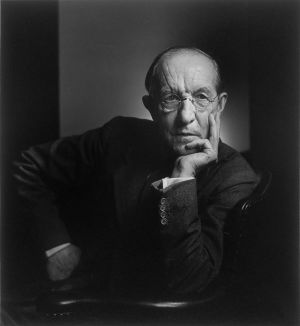
Duncan Campbell Scott, a Canadian poet, musician and civil servant, played a prominent role in forging a uniquely Canadian literary vocabulary. Scott’s unique Canadian literary voice drew sketches of the Canadian landscape and its people and was often influenced by British and American thought.[2](Bennet and Brown 190) Some of his more prominent and popular works contain portraits of “new world” Canadian aboriginal people and their culture. Indeed, with a deft hand, Scott captures with an unsettling poetic rage a stoic, heroic Chipewyan woman in “The Forsaken” and a spirited Onondagan mother in “The Onondaga Madonna.” While these two poems are constructs of Scott's literary artistic imagination, and aesthetic sensibilities, they are also informed by his direct interactions with Canada's aboriginal people and his own Eurocentric values and opinions. Thus these two works, in a sense, when considered together, map an important transition within Scott's own literary tradition and are demonstrative of his changing perspective on aboriginal culture, shifting from a Eurocentric approach to a more modern, realistic point of view. Indeed, these works are a as much a portrait of the artist as a portrait of the sitter.
Biographical Information
Duncan Campbell Scott was born the son of an English Methodist Preacher on August 2nd, 1862 in Ottawa and spent his early years in small towns and villages of Quebec and Ontario. From his father Scott inherited an interest in classical literature and from his mother an interest in music. Initially interested in a career in medicine but lacking the financial means to attend medical school, Scott obtained a clerkship position in the Department of Indian Affairs at 17 years of age. He retired in 1932 from that same department. Over the 53 years he remained the civil service Duncan Campbell Scott rose from copy clerk to head of the accounting branch(1891) to superintendent of education(1909) and finally to head of the department(1919). It was through his role as a civil servant Scott first met Archibald Lampman, the Canadian poet who was to introduce Scott to writing and the literary community. The two became good friends and remained so until Lampman's death at age 37. Scott's passion for both music and poetry served anchor him within the Ottawa arts scene. Duncan Campbell Scott was married for the first time in October 1894 to professional violinist Belle Warner, whom he met while acting as her accompanist for a recital. They had one child, Elizabeth Duncan in 1895.In 1907, Elizabeth was sent to a convent school in Paris, France where she died that same year of Scarlet Fever. Numerous sources state that Scott never recovered from this loss, and kept some of his daughter’s toys until he died. Belle died in 1929 and two years later Scott was married again, this time to an aspiring poet, Elise Aylen. They remained together until his death in 1947.
The 'Indian Problem'
Historical Context
In the initial competition between France and Britain for North American dominance, the indigenous peoples, especially those of "the Iroquois Confederacy, were vital military allies." (Titley 2). This alliance continued to be valued even after the triumph of Britain on the Plains of Abraham, as reflected in the Royal Proclamation of 1763, which "tacitly acknowledged aboriginal land title and suggested procedures of surrender that were later incorporated into the treaty system." (Titley 2) As colony grew in strength and size, the military necessity of the Indians became decreased and an appetite for the lands they occupied increased. As Titley puts it, the "transfer of the [Indian] department from military to civilian control in 1830 signified that the relationship between the two peoples had changed fundamentally." (3) The Indian Department was funded in part by government grants. The remaining funds were generated by "the sale of Indian land and of resources therefrom." (Titley 3) As the local fur trade declined, European illnesses ravaged their communities and their lands were taken for settlement, the Indians found their economic independence seriously compromised. The Indian Department decided that assimilation into the white population was the only viable solution to this "Indian problem."
Policy and Perceptions
Any contemporary reading and understanding of Scott's poetry will be inevitably marred by the many controversial aboriginal government policies he helped shape during his career as the head of the Department of Indian Affairs. Scott firmly believed that the British North America Act "had given to the federal government 'the burden of the Indian'". (Titley 36). Scott was eager to "reform" or better integrate Canada's aboriginal peoples into mainstream Euro-Canadian society. Indeed, "he expressed his eagerness that the Indians adopt agriculture, or at least cultivate gardens, and that 'habits of industry and thrift' be encouraged." (Titley 36).
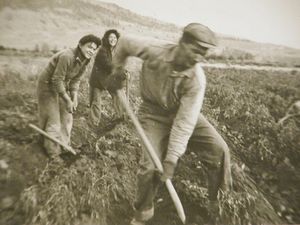
To realize this vision, Scott implemented policies such as compulsory attendance of aboriginal children aged 6 to 16 at residential schools
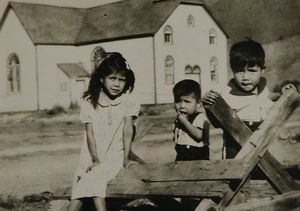
and prohibited religious ceremonies such as the Potlach and the Sun Dance Festival.
While many aboriginal people resisted Scott's policies, employing legal mechanisms to shake government control of aboriginal people and reserve lands, Scott effectively quashed any aboriginal legal claims by writing to the deputy minister of justice seeking an amendment to the Indian act "which would prevent lawyers and agitators collecting money from Indians for the pursuit of claims against the government without department approval." (Titley 59). In 1927, this proposal was in fact incorporated into the Indian Act, effectively silencing Indian legal claims and actions against the government.
As previously mentioned, any reading or interpretation of Scott's work will inevitably prey upon his checkered record as a civil servant who devoted his time to the assimilation of Canada's aboriginal peoples. The video clip below captures one individual's thoughts with respect to Scott's, and the Department of Indian Affair's, social policy.
Works (Poetry)
For the purposes of our analysis, we will be considering two of Scott's more popular works--"The Onondaga Madonna," written in 1898, and "The Forsaken," written in 1905--which are reproduced in their entirety below. Although only seven years of age separates these two works, we have discovered, and we believe you will agree, that these two works speak to an important transitional period in Scott's own work. Specifically, a transition from the employment of "Euro-Christian-centric" descriptors, as seen in the "The Onondaga Madonna", to a more New World portrayal of Canada's aboriginal people, as seen in "The Forsaken."
The Onondaga Madonna
She stands full-throated and with careless pose,
This woman of a weird and waning race,
The tragic savage lurking in her face,
Where all her pagan passion burns and glows;
Her blood is mingled with her ancient foes,
And thrills with war and wildness in her veins;
Her rebel lips are dabbled with the stains
Of feuds and forays and her father’s woes.
And closer is the shawl about her breast,
The latest promise of her nation’s doom,
Paler than she her baby clings and lies,
The primal warrior gleaming from his eyes;
He sulks, and burdened with his infant gloom,
He draws his heavy brows and will not rest.
1898
The Forsaken
(For analytical purposes, Scott's "The Forsaken" is presented in two columns. Presenting the two sections side-by-side highlights the poem's parallel structure.)
|
I |
II |
|
Once in the winter Out on a lake In the heart of the north-land, Far from the Fort And far from the hunters, A Chippewa woman With her sick baby, Crouched in the last hours Of a great storm. Frozen and hungry, She fished through the ice With a line of the twisted Bark of the cedar, And a rabbit bone hook Polished and barbed; Fished with the bare hook All through the day, Fished and caught nothing; While the young chieftain Tugged at her breasts, Or slept in the lacings Of the warm tikanagan. All the lake-surface Streamed with the hissing Of millions of iceflakes, Hurled by the wind; Behind her the round Of a lonely island Roared like a fire With the voice of the storm In the deeps of the cedars. Valiant, unshaken, She took of her own flesh, Baited the fish-hook, Drew in a grey-trout, Drew in his fellows, Heaped them beside her, Dead in the snow. Valiant, unshaken, She faced the long distance, Wolf-haunted and lonely, Sure of her goal And the life of her dear one; Tramped for two days, On the third in the morning, Saw the strong bulk Of the Fort by the river, Saw the wood-smoke Hang soft in the spruces, Heard the keen yelp Of the ravenous huskies Fighting for whitefish: Then she had rest. |
Years and years after, When she was old and withered, When her son was an old man And his children filled with vigour, They came in their northern tour on the verge of winter, To an island on a lonely lake. There one night they camped, and on the morrow Gathered their kettles and birch-bark Their rabbit-skin robes and their mink-traps, Launched their canoes and slunk away through the islands, Left her alone forever, Without a word of farewell, Because she was old and useless, Like a paddle broken and warped, Or a pole that was splintered. Then, without a sigh, Valiant, unshaken, She smoothed her dark locks under her kerchief, Composed her shawl in state, Then folded her hands ridged with sinews and corded with veins, Folded them across her breasts spent with the nourishing of children, Gazed at the sky past the tops of the cedars, Saw two spangled nights arise out of the twilight, Saw two days go by filled with the tranquil sunshine, Saw, without pain, or dread, or even a moment of longing: Then on the third great night there came thronging and thronging Millions of snowflakes out of a windless cloud; They covered her close with a beautiful crystal shroud, Covered her deep and silent. But in the frost of the dawn, Up from the life below, Rose a column of breath Through a tiny cleft in the snow, Fragile, delicately drawn, Wavering with its own weakness, In the wilderness a sign of the spirit, Persisting still in the sight of the sun Till day was done. Then all light was gathered up by the hand of God and hid in His breast, |
1905
Analysis
Prosody of Onondaga Madonna
"The Onondaga Madonna" follows the form of an Italian sonnet, its fourteen lines are divided into an octave with the rhyme scheme abbaacca followed by a sestet with the rhyme scheme deffed. The octave is marked by alliteration on all even numbered lines, eg, ‘weird and waning’ (Line 2).
The octave vividly describes a native woman and foretells the impending extinction of her people. We learn mainly from her face that she is a savage pagan, aggressive in stance and violent in temperament. She stands chin up, throat exposed (Line 1), defiant of the precarious nature of her peoples’ existence (Line 2). Her face, where the ‘tragic savage lurks’ (Line 3) and her ‘pagan passion burns’ (Line 4) for all to see, gives no hint of civility. Her lips are ‘dabbled with the stains of feuds and forays’ (Lines 7, 8) hinting at the drinking the blood of enemies killed in battle.
The sestet focuses on the demise of the Onondaga people. The woman’s son, ‘Paler than she’ (Line 11) is at least half white. Intermarriage with the Europeans was generally considered to facilitate the assimilation of the native peoples into European dominated society. Even so, the ‘primal warrior gleaming from eyes’ (Line 12) indicates his soul is not that of ‘civilized’ society. This is no prophet bringing word of God’s love. In line 14 we find 'He will not rest', perhaps because by virtue of his mixed blood he belongs to neither aboriginal or white society - he is doomed to be trapped in the middle, never fully accepted by either.
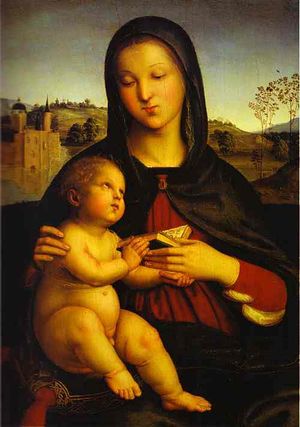
The title of this poem is heavily ironic. In using the Biblical allusion to the Madonna, the mother of Jesus Christ, the multifaceted contradiction is vividly conveyed. The Onondaga woman is instantly recognizable as the antithesis of the Virgin Mary, and her description invites a clear and stark juxtaposition with the serene and calm beauty of the Madonna as depicted in the renaissance painting by Raphael "Madonna and Child." Indeed, the Onondaga Madonna's pose is defiant instead of modest, her demeanor savage instead of mild, she is pagan instead of monotheistic, and her child a harbinger of doom rather than a savior. Scott, in using Christian iconography to introduce the Onondaga woman, aggravates the social and cultural divide between European settlers and the aboriginal peoples, immediately casting the Onondaga woman as the "anti" Madonna (perhaps the savage Madonna).
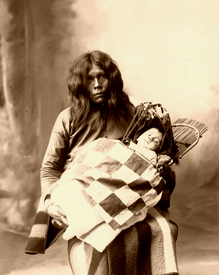
Indeed, the Onondaga woman's demeanor and appearance does not readily coincide with any pre-existing euro-conceptions of female beauty, and Scott does not lend her the type of flattering language that one would typically encounter in 19th century literary depictions of the Christian Madonna. Indeed, "Scott best articulates the assumptions that underlay Canadian Indian policy in his day." (Titley 36). Thus is Scott's Onondaga Madonna a Eurocentric contrast, one that perhaps explains early Canadian aboriginal policy.
The overall theme or message of the poem is clear. 'Indians' are savage, violent people controlled by blood lust. Incapable of rationality, they have no hope for survival in their current state and so their race is doomed to vanish, through assimilation to ‘white’ ways, dilution of their ‘wild’ blood by marriage to whites or death.
The Prosody of The Forsaken
"The Forsaken" tells the story of a woman who has been twice forsaken (abandoned or renounced) – once as a young mother in Part I and once as an old woman in Part II.
In Part I she is a young mother, caught out alone on a frozen lake in a severe storm, ‘Frozen and hungry’ (Line 10) with her sick baby.

Here the use of short phrases emphasizes the icy desolation of the setting. The storm is a blizzard (Line 25), and the wind is howling through the cedar trees (Line 29). To get food she fishes through the ice in a traditional way, using a rabbit bone hook on a cedar bark line. She has no luck until she sacrifices some of her own flesh to bait the hook. Once she has amassed a heap of fish, she calmly faces a multi-day trek through wolf country to get herself and her baby to the safety. On the third day, she sees the chimney smoke of the fort hanging in the trees and hears the sled dogs. At this point she can succumb to her exhaustion.
In Part II she is an old grandmother, traveling with her son and his family. She has reached the end of her useful life, and is left behind after a stop on an island in a lake. It is not yet winter and the lake is not frozen, the family travels by canoe (Line 63). Instead of traditional hunting methods, they have adopted the mink-traps of the European hunters. As a young mother she struggled against the elements to survive and save her son, but now as a grandmother she stoically composes herself and waits for death. She observes two days of clear weather, ‘two spangled nights’ and ‘tranquil sunshine’ (Lines 76 & 77). On the third day it begins to quietly, gently snow and the flakes encase her in ‘a beautiful crystal shroud’ (Line 81). That day she takes one last, fragile breath and is gone- she has succumbed to her death. The two parts are strictly parallel, every element is common to both parts, yet opposing in each. The only constancy is the protagonist, who displays courage and composure as she fulfills her duty to her son in each case; ‘Valiant, unshaken’ (Lines 39 &70). Part I is loud, the wind howls, the huskies yelp whereas Part II is quiet, her family slinks away, without saying goodbye and there is ‘a silence deep than silence’ (Line 93). In Part I the smoke hangs heavy in the spruce trees; in Part II her last breath rises, ‘wavering with its own weakness’ (Line 88). In Part I the protagonist uses all her strength to survive by trekking through the snow but in Part II she surrenders and patiently awaits her death. After completion of each of these trials ‘she has rest’ (Lines 53 & 94) Scott uses the woman as a reference point for the cultural demise he saw in the Chippewa people. In the life span of the Chippewa mother he shows traditional practices falling out of use and traditional ways corrupted. In line 63 the son and his family ‘Launched their canoes and slunk away’. Elder abandonment was an accepted practice – as supported by the lack of distress the grandmother displayed – so why the used of the word ‘slunk’? Perhaps the younger generation had assimilated enough of the European ways to feel guilt for these actions.
Literary Development Across the Two Poems
"The Onondaga Madonna" was published in 1898; "The Forsaken" was published seven years later, in 1905. In 1905, D.C. Scott was part of an expedition into Northern Ontario, the purpose of which was to obtain signatures on a number of treaty documents. The experience gave him direct contact with the Native peoples, which is evidenced by changes in his poetry. In 'The Onondaga Madonna', a strong European influence is evident in the use of the Italian sonnet form, of Christian iconography, and the profusion of alliterative descriptors. The negative connotations associated with many of the adjectives used, such as ‘weird’ and ‘pagan’, give a sense of negative judgment of the Onondaga as a people. In contrast, "The Forsaken" is structured as a less formal narrative. Instead of profuse description, D.C. Scott relies on sparse phraseology to convey the cold, desolate landscape. The vocabulary is also different; his use of the Chippewa word tikanagan and description of the cedar bark fishing line demonstrate an increasing knowledge and understanding of Chippewa culture. Christian influence is still evident in the ‘beautiful crystal shroud’ of Line 81 and the appearance of ‘the hand of God’ on Line 92. It is also evident in the concept of duty present in both halves of the poem; in Part I a mother’s duty to her child and in Part II an elder’s duty to her family. What has changed is the atmosphere of negative judgment of "The Onondaga Madonna"; in "The Forsaken" there is a sense of admiration for the courageous stoicism the woman exhibits. Nonetheless, Scott remains constant in his belief that aboriginal culture was ultimately doomed. For Scott in particular, this was not simply a personal belief or echo of popular opinion, but very much a professional goal.
Conclusion
Scott's "The Onondaga Madonna" and "The Forsaken" are literary artistic creations shaped by Scott's interactions with Canada's aboriginal peoples. "The Onondaga Madonna" makes overt literary references to Eurocentric Christian values and sentiments. Scott's multifaceted juxtaposition between the Christian Madonna and the Onondaga woman illustrates the deep divide between 19th Century European conceptions of feminine beauty and the Canadian government's valuation of Canada's aboriginal peoples. The biblical allusions in both works illuminate Scott's own Eurocentric opinions and beliefs. However, when one considers Scott's later work, an important literary transition can be discerned. Scott's use of aboriginal terminology and description of aboriginal fishing methods in "The Forsaken" show an increasing familiarity with aboriginal culture. As a result the poem as a whole is a departure from the Christian terminology and underlying themes found in "The Onondaga Madonna." Indeed, when the works are considered together they map an important transition within Scott's own literary tradition, shifting from European literary traditions to a more modern, authentic artistic rendering.
Questions to think about
a.) In "The Onondaga Madonna" the aboriginal peoples are portrayed as being savage by virtue of the very blood in their veins, i.e. by race or genetics. Do you think that Duncan Scott used this as justification for the draconian policies of his administration?
b.) How is Scott's portrayal of aboriginals, specifically aboriginal women, connected to 19th century conceptions of culture and "cultured" that were present in his day? (A quick consultation with the Oxford English Dictionary may prove helpful.)
c.) In "The Forsaken" Part I, why is the young mother alone on the lake in the storm? Is she in quarantine to prevent the spread of her baby's illness to other band members? Or has she been cast out for another reason, perhaps the paternity of the child? Why does she go to the fort instead of her people?
d.) Scott's use of the Chippewa word, tikanagan is arguably a very significant development in Canadian Literary Identity. It could also be interpreted as Cultural Appropriation, especially given Scott's non-poetic pursuits. Do you think Scott's use of aboriginal culture is too reminiscent of the Indian Department's appropriation of aboriginal land to be excused?
Works Cited
Bennet, Donna, and Brown, Russel, eds. A New Anthology of Canadian Literature in English. Canada: Oxford University Press, 2002. Print.
Duncan Campbell Scott: The Poet and The Indians. Dir. James Cullingham. Tamarack Productions and The National Film Board of Canada, 1995. Film.
Photo from http://www.legendsofamerica.com/
Raphael. Madonna and Child. c.1503. Oil on panel. Norton Simon Museum of Art, Pasadena, USA. from Olga's Gallery http://www.abcgallery.com/R/raphael/raphael14.html
“Scott, Duncan Campbell (1862-1947).” National Lampoon. June 1983. in Titley, E. Brian. A Narrow Vision. Vancouver, B.C.: University of British Columbia Press, 1986. ix.
The Fallen Feather: Indian Industrial Residential Schools, Canadian Confederation. The Fallen Feather, 2007. Photographs. http://www.fallenfeatherproductions.com/
Titley, E. Brian. A NARROW VISION: Duncan Campbell Scott and the Administration of Indian Affairs in Canada. Vancouver: University of British Columbia Press, 1986. Print.
Thomson, Tom. April in Algonquin. 1917. Painting. <http://en.wikipedia.org/wiki/Tom_Thomson>
- ↑ “Scott, Duncan Campbell (1862-1947).” National Lampoon. June 1983. in Titley, E. Brian. A Narrow Vision. Vancouver, B.C.: University of British Columbia Press, 1986. ix.
- ↑ Bennett, Donna and Russell Brown, ed. A New Anthology of Canadian Literature in English. Toronto: Oxford University Press, 2002. 190.
- ↑ The Fallen Feather: Indian Industrial Residential Schools, Canadian Confederation. The Fallen Feather, 2007 http://www.fallenfeatherproductions.com/
- ↑ The Fallen Feather: Indian Industrial Residential Schools, Canadian Confederation. The Fallen Feather, 2007 http://www.fallenfeatherproductions.com/
- ↑ Raphael. Madonna and Child. c.1503. Oil on panel. Norton Simon Museum of Art, Pasadena, USA. from Olga's Gallery http://www.abcgallery.com/R/raphael/raphael14.html
- ↑ Photo from http://www.legendsofamerica.com/
- ↑ Thomson, Tom. April in Algonquin. 1917 <http://en.wikipedia.org/wiki/Tom_Thomson>"